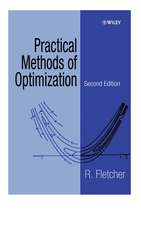Analytical Dynamics of Discrete Systems: Mathematical Concepts and Methods in Science and Engineering
Autor R. Rosenbergen Limba Engleză Paperback – 11 dec 2012
Din seria Mathematical Concepts and Methods in Science and Engineering
-
 Preț: 402.38 lei
Preț: 402.38 lei -
 Preț: 395.47 lei
Preț: 395.47 lei -
 Preț: 386.39 lei
Preț: 386.39 lei -
 Preț: 397.59 lei
Preț: 397.59 lei -
 Preț: 400.10 lei
Preț: 400.10 lei -
 Preț: 384.31 lei
Preț: 384.31 lei -
 Preț: 384.48 lei
Preț: 384.48 lei -
 Preț: 390.08 lei
Preț: 390.08 lei -
 Preț: 382.75 lei
Preț: 382.75 lei -
 Preț: 386.39 lei
Preț: 386.39 lei - 20%
 Preț: 642.52 lei
Preț: 642.52 lei -
 Preț: 398.15 lei
Preț: 398.15 lei -
 Preț: 388.90 lei
Preț: 388.90 lei -
 Preț: 387.96 lei
Preț: 387.96 lei - 15%
 Preț: 653.79 lei
Preț: 653.79 lei - 20%
 Preț: 333.72 lei
Preț: 333.72 lei - 15%
 Preț: 639.25 lei
Preț: 639.25 lei - 20%
 Preț: 336.86 lei
Preț: 336.86 lei -
 Preț: 382.75 lei
Preț: 382.75 lei - 15%
 Preț: 653.00 lei
Preț: 653.00 lei - 15%
 Preț: 604.70 lei
Preț: 604.70 lei -
 Preț: 391.02 lei
Preț: 391.02 lei - 18%
 Preț: 946.72 lei
Preț: 946.72 lei - 18%
 Preț: 956.69 lei
Preț: 956.69 lei -
 Preț: 388.90 lei
Preț: 388.90 lei - 18%
 Preț: 956.18 lei
Preț: 956.18 lei - 15%
 Preț: 644.63 lei
Preț: 644.63 lei - 18%
 Preț: 957.32 lei
Preț: 957.32 lei - 18%
 Preț: 1233.37 lei
Preț: 1233.37 lei - 18%
 Preț: 1233.52 lei
Preț: 1233.52 lei -
 Preț: 392.37 lei
Preț: 392.37 lei - 18%
 Preț: 957.94 lei
Preț: 957.94 lei - 15%
 Preț: 638.89 lei
Preț: 638.89 lei - 18%
 Preț: 950.03 lei
Preț: 950.03 lei - 15%
 Preț: 648.74 lei
Preț: 648.74 lei
Preț: 782.07 lei
Preț vechi: 953.75 lei
-18% Nou
Puncte Express: 1173
Preț estimativ în valută:
149.67€ • 162.52$ • 125.72£
149.67€ • 162.52$ • 125.72£
Carte tipărită la comandă
Livrare economică 22 aprilie-06 mai
Preluare comenzi: 021 569.72.76
Specificații
ISBN-13: 9781468483208
ISBN-10: 146848320X
Pagini: 448
Ilustrații: XVIII, 426 p. 1 illus.
Dimensiuni: 152 x 229 x 24 mm
Greutate: 0.6 kg
Ediția:Softcover reprint of the original 1st ed. 1977
Editura: Springer Us
Colecția Springer
Seria Mathematical Concepts and Methods in Science and Engineering
Locul publicării:New York, NY, United States
ISBN-10: 146848320X
Pagini: 448
Ilustrații: XVIII, 426 p. 1 illus.
Dimensiuni: 152 x 229 x 24 mm
Greutate: 0.6 kg
Ediția:Softcover reprint of the original 1st ed. 1977
Editura: Springer Us
Colecția Springer
Seria Mathematical Concepts and Methods in Science and Engineering
Locul publicării:New York, NY, United States
Public țintă
ResearchCuprins
1. Introduction.- 2. Dynamical Systems.- 2.1. Particles.- 2.2. Systems of Particles.- 2.3. Forces and Laws of Motion.- 2.4. Galilean Transformations.- 2.5. Arguments of the Forces.- 2.6. The Problems of Particle Mechanics.- 3. Representations of the Motion.- 3.1. The Configuration Space.- 3.2. The Event Space.- 3.3. The State Space.- 3.4. The State-Time Space.- 3.5. Notions on the Concept of Stability.- 3.6. Problems.- 4. Constraints.- 4.1. General Observations.- 4.2. Holonomic Constraints.- 4.3. Nonholonomic Constraints.- 4.4. The Pfaffian Forms.- 4.5. When is a System of Constraints Holonomic?.- 4.6. Accessibility (of the Configuration Space).- 4.7. Problems.- 5. The Strictly Newtonian Mechanics Problem.- 5.1. General Remarks.- 5.2. The Given Quantities and Relations.- 5.3. The First Problem.- 5.4. The Second Problem.- 5.5. Other Problems.- 5.6. Concluding Remarks.- 6. Some Rigid Body Kinematics.- 6.1. The Rigid Body.- 6.2. Finite Rotation.- 6.3. The Direction Cosines.- 6.4. Orthogonal Transformations.- 6.5. The Matrix Notation.- 6.6. Properties of the Rotation Matrix.- 6.7. The Composition of Rotations.- 6.8. Applications.- 6.9. Problems.- 7. Some Rigid Body Kinetics.- 7.1. Introductory Remarks.- 7.2. The Inertial Parameters in Rotated Axes.- 7.3. Angular Momentum and Principal Axes.- 7.4. The Ellipsoids of Cauchy and Poinsot.- 7.5. The General Motion of Rigid Bodies.- 7.6. Problems.- 8. The Nature of Lagrangean Mechanics.- 8.1. General Remarks.- 8.2. The Generalizations by Lagrange.- 9. Virtual Displacement and Virtual Work.- 9.1. General Observations.- 9.2. Classification of Displacements.- 9.3. D’Alembert’s Principle.- 9.4. The Nature of the Forces of Constraint.- 9.5. The Virtual Velocity.- 9.6. The Variation.- 9.7. Possible Velocities and Accelerations.-9.8. The Fundamental Equation.- 9.9. The Nature of the Given Forces.- 9.10. Given Forces Which Are Functions of Constraint Forces.- 9.11. Problems.- 10. Hamilton’s Principle.- 10.1. The Kinetic Energy.- 10.2. Kinetic Energy in Catastatic Systems.- 10.3. The Energy Relations in Catastatic Systems.- 10.4. The Central Principle.- 10.5. The Principle of Hamilton.- 10.6. Noncontemporaneous Variations.- 10.7. Lagrange’s Principle of Least Action.- 10.8. Jacobi’s Principle of Least Action.- 10.9. Problems.- 11. Generalized Coordinates.- 11.1. Introductory Remarks.- 11.2. The Theory of Generalized Coordinates.- 11.3. The Nature of Generalized Coordinates.- 11.4. The ? Operator for Generalized Coordinates.- 11.5. Exceptional Cases.- 11.6. Problems.- 12. The Fundamental Equation in Generalized Coordinates.- 12.1. The Kinetic Energy.- 12.2. Two Equalities.- 12.3. The Fundamental Equation.- 12.4. Generalized Potential Forces.- 12.5. Velocity-Dependent Potentials.- 12.6. Problems.- 13. Lagrange’s Equations.- 13.1. The Dynamical Problem.- 13.2. The Multiplier Rule.- 13.3. Derivation from the Fundamental Equation.- 13.4. Derivation from the Central Principle.- 13.5. Derivation from Hamilton’s Principle.- 13.6. Dynamic Coupling and Decoupling.- 13.7. Special Forms of Lagrange’s Equations.- 13.8. The Principle of LeastAction Reconsidered.- 13.9. Problems.- 14. Embedding Constraints.- 14.1. Introductory Remarks.- 14.2. A Fallacy.- 14.3. Embedding of Nonholonomic Constraints..- 14.4. Problems.- 15. Formulating Problems by Lagrange’s Equations.- 15.1. General Remarks.- 15.2. The Unconstrained Particle.- 15.3. The Holonomically Constrained Particle.- 15.4. The Nonholonomically Constrained Particle.- 15.5. Systems of Particles and Rigid Bodies.- 15.6. Problems.- 16. TheIntegration.- 16.1. The Meaning of an Integral.- 16.2. Jacobi’s Integral.- 16.3. TheRouthianFunctionandtheMomentumIntegrals.- 16.4. Partial and Complete Separation of Variables.- 16.5. Solution in Quadratures.- 16.6. Qualitative Integration.- 16.7. Problems.- 17. Stability.- 17.1. Introductory Remarks.- 17.2. Definition of Stability.- 17.3. The Variational Equations.- 17.4. Some Remarks on Indirect Methods.- 17.5. Some Remarks on Liapunov’s Direct Method.- 17.6. Problems.- 18. Applications.- 18.1. Introductory Remarks.- 18.2. The Single Particle.- 18.3. Systems of Particles.- 18.4. Nonholonomic Systems.- 18.5. Problems.- 19. About Celestial Problems.- 19.1. Historical Notes.- 19.2. The Central Force Problem.- 19.3. The Central Force Problem Continued—The Apsides.- 19.4. The Central Force Problem Continued—On Bertrand’s Theorem.- 19.5. The n-Body Problem.- 19.6. The Two-Body Problem.- 19.7. Some Information about the Three-Body Problem.- 19.8. Problems.- 20. Topics in Gyrodynamics.- 20.1. Introduction.- 20.2. The Heavy Symmetrical Top.- 20.3. The Gyroscope.- 20.4. The Gyrocompass.- 20.5. Problems.- 21. Impulsive Motion.- 21.1. General Remarks.- 21.2. The Fundamental Equation.- 21.3. Impulsive Constraints.- 21.4. The Fundamental Equation with Impulsive Constraints.- 21.5. Impulsive Motion Theorems.- 21.6. Lagrange’s Equations for Impulsive Motion.- 21.7. Problems.














